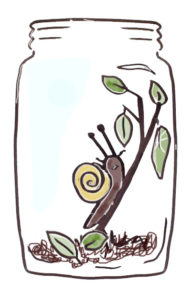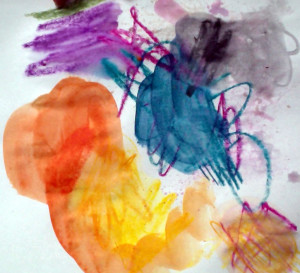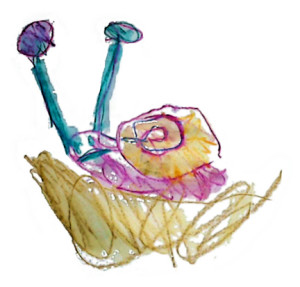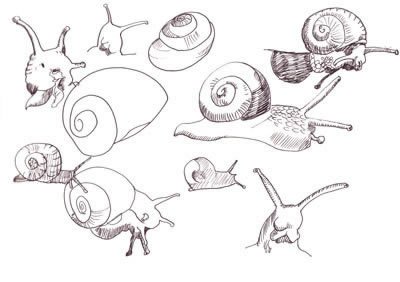Integrating science observation and art provides opportunities for children to practice the skills of investigation and experience new art materials and methods. Purposely make your classroom a place that invites observation, provides students with moments to connect with living things and a space to reflect on those experiences.
Rather than telling students facts about snails, for instance, engage in observation and research behaviors yourself and model recording your own observations.

Keep it Simple – Preparing for these type of experiences can be as easy having a large empty glass jar available and asking a couple of older students to collect a couple of live specimens and plant material, before the school day begins. Return the creatures to the same place at lunch time or at the end of the day.
Suggested weekly sequence so students experience:
- observing and asking questions
- recording observations
- exploring an art material or method
- creating pictures of observations using a specific art method or material
1. Schedule time
When you set up a schedule that allows time for observation and for asking questions and wondering, you show your students that those skills have value. If your students are too busy filling in worksheets about snails, they have little time left for actual observation and interaction with them.
2. Set up the classroom environment
By setting up the classroom environment in a specific way, with plenty of real things for children to explore, you structure the surroundings to match the way kids learn. Children learn about nature and other topics through real interactions with them, not from coloring or matching similar pictures on worksheets.
As well as providing real things, add literacy materials, such as books about snails, empty stapled booklets, markers, recording sheets, and pictures cards with snail related words. Read more about setting up a nature center here…
3. Investigate and record – Monday to Wednesday
- Gather snails and bits of plants (scroll down on this page to learn how to take care of living things in the classroom).
- Schedule a few days for students to observe and ask questions about real snails.
- Provide time for students to record their observations of snails.
During this time model a few different ways to observe and record your own observations of snails.
Remind children why we record our observations
Briefly remind children why it’s great to record their observations – so they can share the information with others.
This demonstrates to the children that their observations have value and that once recorded, they can be shared with many people.
An example of one way of recording what is significant to you about the snails.
 TIP!! Keep demonstrations like the one below short!
TIP!! Keep demonstrations like the one below short!
It might go something like this.
I have been looking at the snails today.
First I noticed that the snail’s body under its shell bends easily when it crawls over the sticks, so I am going to draw a stick first. Now I’m drawing a snail shell, it’s a spiral shape, and then the snail’s body coming out of its shell and bending over the stick here. (Introduce vocabulary as you draw.)
I also saw the snail stretch and shrink its tentacles, so I am drawing one long stretchy tentacle and one short tentacle.
Many students are eager to record their own snail observations at this time. Others will need more time. Have recording sheets near the animal and prompt with something like this. “Draw something you noticed about the snails. We can share our observations after snack.”
4. Explore Art Materials – Thursday
Have an art exploration time, either in small groups or whole class, inviting children to discover what the art materials you put out can do and different ways of controlling them. Choose any art materials available. Watercolor crayons were used in the image below.
Use an “I wonder” approach…

I wonder what would happen if…
- we mixed these two colors on the paper
- we draw with the watercolor crayons on dry paper
- we sprayed water on the colors on dry paper
- we flicked a wet brush on the end of the crayon (splatters)
- we wet the paper first and then draw with the crayons
- dabbed a wet brush on the end of the crayon and made lines
- dipped our fingers in water, rubbed the end of the crayon and then made lines
5. Finally, combine the observations and explorations! – Friday

On the last day of the week, invite students to draw snails using the art materials from the day before. The children’s prior experiences with the art materials combined with the time they had to observe the actual living things will provide them with plenty of experience and visual imagery to create their snail pictures.

- I removed all the black and brown watercolor crayons to prevent a mass of mud pictures!
- Provide larger sheets of paper and ask students to create big snail pictures by drawing the snails larger than their hands (show them). This prevents a page of tiny circles on a large sheet of paper.
Suggested Resources
Watercolor crayons are one art material your students may not be too familiar with. Some are student quality and more affordable than the artists quality. Artist quality generally have more pigment and thus, more vivid colours.
Watercolor crayons can be applied to dry or wet paper. You can use them like regular crayons and then go over them with a brush dipped in water to obtain a watercolor effect. You can also go back over the painting, after the water has dried, with a dry crayon to outline and add details.
Faber-Castell watercolor crayons are another student quality set for young artists. Read the customer reviews for more details.
Note:
All the brands of watercolor crayons break more easily than regular crayons.
There are many other art materials and techniques for children to experiment with as well. Whatever art material you pick, allow plenty of time for the children to play with them first.
The above brands are student quality and are more reasonably priced for the classroom than the brand below.
One more thing…
Caran d’Ache Classic Neocolor II Water-Soluble Pastels are amazing, made in Switzerland and used for students and by professional artists. They are artist quality and considerably more expensive than the two brands above. I have a set I keep for myself and love the subtle colors I can achieve with them.
Neocolor II Water Soluble Pastels”
They look like a box of crayons but have a high pigment concentration, great covering power and can be used dry or wet on a wide variety of materials. They are simple to use and meet child safety standards.
So if you are art inclined,




